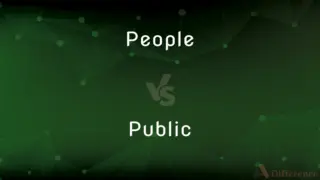Appendix vs. Glossary — What's the Difference?
By Tayyaba Rehman & Urooj Arif — Updated on April 8, 2024
An appendix contains supplementary material, while a glossary lists terms with definitions.

Difference Between Appendix and Glossary
Table of Contents
ADVERTISEMENT
Key Differences
An appendix is a section at the end of a document that provides additional information to support the main text, such as charts, tables, and references, enhancing the reader's understanding. On the other hand, a glossary is a dedicated section listing specialized terms found within the document, offering definitions or explanations to aid comprehension.
Appendices often include data that is too detailed for the main body of the document, allowing authors to present their full findings without interrupting the narrative flow. Whereas, glossaries focus on clarifying the meanings of specific terms, making them indispensable for readers unfamiliar with the subject matter or jargon.
The content of an appendix can vary widely, including but not limited to research methodologies, statistical data, and supplementary evidence. In contrast, a glossary uniformly consists of alphabetically arranged terms followed by brief definitions or translations.
While an appendix enhances the document by providing depth and supporting evidence, it is not essential for understanding the main text. However, a glossary directly contributes to the reader's understanding by defining key terms, potentially making it crucial for navigating through complex topics.
In academic and technical writing, appendices serve as a repository for extensive research that underpins the work, showcasing the rigor of the investigation. Glossaries, on the other hand, ensure accessibility, enabling readers across different levels of expertise to grasp specialized or unfamiliar terminology.
ADVERTISEMENT
Comparison Chart
Purpose
Provides supplementary material to support the document's content.
Lists and defines terms used in the document.
Content
Can include raw data, charts, questionnaires, and detailed explanations.
Consists of alphabetically listed terms with definitions or explanations.
Location
Typically found at the end of a document.
Also located at the end of a document but sometimes placed at the beginning in some publications.
Necessity
Enhances understanding but not essential for the main text.
Essential for understanding specialized terms or jargon.
Audience
Aimed at readers seeking deeper insight or verification of the information.
Aimed at all readers, especially those unfamiliar with the document's specific terminology.
Compare with Definitions
Appendix
A supportive section in academic writing.
The thesis appendix includes a detailed methodology of the research conducted.
Glossary
A reference section in a book for specialized terms.
The medical textbook’s glossary simplifies complex terms.
Appendix
A section at the end of a book or document containing additional information.
The research paper’s appendix includes raw data from the experiments.
Glossary
A list of terms in a special subject, field, or area of usage, with accompanying definitions.
The technical manual includes a glossary of terms at the end.
Appendix
An attachment to a document providing further detail.
The appendix to the report contains the survey questions used.
Glossary
Alphabetically arranged list of words with explanations.
New students should refer to the glossary for definitions of academic terms.
Appendix
Additional content in a document for reference purposes.
For further reading, see the appendix containing recommended articles.
Glossary
A part of a book defining technical or unfamiliar terms.
To understand the novel’s historical context, check the glossary for period-specific terms.
Appendix
Supplementary material added to the end of a book.
The novel’s appendix features a list of historical dates relevant to the story.
Glossary
A collection of terms and their meanings in a book.
The cookbook’s glossary explains culinary terms used throughout.
Appendix
An appendage.
Glossary
A glossary (from Ancient Greek: γλῶσσα / language, speech, wording) also known as a vocabulary or clavis, is an alphabetical list of terms in a particular domain of knowledge with the definitions for those terms. Traditionally, a glossary appears at the end of a book and includes terms within that book that are either newly introduced, uncommon, or specialized.
Appendix
A collection of supplementary material, usually at the end of a book.
Glossary
An alphabetical list of words relating to a specific subject, text, or dialect, with explanations; a brief dictionary
A glossary of Inuktitut words
Appendix
(Anatomy) Any of several supplementary or accessory parts of a bodily organ or structure, especially the vermiform appendix of the large intestine.
Glossary
A list of often difficult or specialized words with their definitions, often placed at the back of a book.
Appendix
Something attached to something else; an attachment or accompaniment.
Glossary
A list of terms in a particular domain of knowledge with their definitions.
At the back of the book you can find the glossary.
Appendix
A text added to the end of a book or an article, containing additional information.
Glossary
A collection of glosses or explanations of words and passages of a work or author; a partial dictionary of a work, an author, a dialect, art, or science, explaining archaic, technical, or other uncommon words.
Appendix
(anatomy) The vermiform appendix.
Glossary
An alphabetical list of technical terms in some specialized field of knowledge; usually published as an appendix to a text on that field
Appendix
(anatomy) Any process, prolongation, or projection.
Appendix
Something appended or added; an appendage, adjunct, or concomitant.
Normandy became an appendix to England.
Appendix
Any literary matter added to a book, but not necessarily essential to its completeness, and thus distinguished from supplement, which is intended to supply deficiencies and correct inaccuracies.
Appendix
The vermiform appendix.
Appendix
Supplementary material that is collected and appended at the back of a book
Appendix
A vestigial process that extends from the lower end of the cecum and that resembles a small pouch
Common Curiosities
Is an appendix necessary for understanding a document?
While an appendix provides depth, it is not essential for understanding the main content of the document.
What is a glossary used for?
A glossary is used to define specialized terms or jargon used in a document, aiding in the reader's comprehension.
Can a document have both an appendix and a glossary?
Yes, a document can have both, with the appendix providing additional information and the glossary explaining key terms.
Where is an appendix usually located?
An appendix is typically located at the end of a document.
How are terms arranged in a glossary?
Terms in a glossary are usually arranged alphabetically.
What kind of information can be found in an appendix?
Information in an appendix can include raw data, statistical analyses, detailed explanations, and additional research material.
What is an appendix in a document?
An appendix is a section at the end of a document containing supplementary material that is too detailed to include in the main text.
Why is a glossary important in a document?
A glossary is important for ensuring that all readers can understand the specialized terms that are critical to the document's subject matter.
Where is a glossary usually located?
A glossary is usually located at the end of a document, though it may sometimes be found at the beginning.
Is it mandatory to read the appendix of a document?
Reading the appendix is not mandatory but can provide deeper insights and a fuller understanding of the subject matter.
How does an appendix differ from a bibliography?
An appendix provides supplementary material and detailed information, while a bibliography lists sources and references.
Can an appendix include multiple sections?
Yes, an appendix can include multiple sections, each providing different types of supplementary material.
How do authors decide what to include in a glossary?
Authors include terms in a glossary that they believe may be unfamiliar to their readers or require clarification to understand the document's content fully.
Are glossaries only found in textbooks?
No, glossaries can be found in various types of documents, including manuals, technical papers, and even novels, wherever specialized terms need clarification.
Can a glossary include pictures or diagrams?
Yes, in some cases, a glossary may include pictures or diagrams to help explain terms more clearly.
Share Your Discovery

Previous Comparison
Wages vs. Payroll
Next Comparison
People vs. PublicAuthor Spotlight
Written by
Tayyaba RehmanTayyaba Rehman is a distinguished writer, currently serving as a primary contributor to askdifference.com. As a researcher in semantics and etymology, Tayyaba's passion for the complexity of languages and their distinctions has found a perfect home on the platform. Tayyaba delves into the intricacies of language, distinguishing between commonly confused words and phrases, thereby providing clarity for readers worldwide.
Co-written by
Urooj ArifUrooj is a skilled content writer at Ask Difference, known for her exceptional ability to simplify complex topics into engaging and informative content. With a passion for research and a flair for clear, concise writing, she consistently delivers articles that resonate with our diverse audience.














































